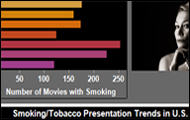
Exposure to smoking in feature films increases the likelihood that young people will start smoking, according to a study recently cited in the Center for Disease Control's Morbidity and Mortality Weekly Report. Youths who are heavily exposed to onscreen smoking are approximately two to three times more likely to begin smoking than youths who are lightly exposed, the study said.
The study, conducted by the Center for Tobacco Control Research and Education at the University of California San Francisco, showed an overall decline in the number of tobacco incidents in movies from 1991 to 2008. Focusing specifically on six major media companies and independent film producers, the study supplied detailed smoking data on movies produced from 1999 through 2008. Use the interactive graph below to explore the number and percentage of movies containing on-screen smoking over time:
The study found that most youth exposure to smoking occurs in PG-13 films. Data show that PG-13 films delivered 65 percent of tobacco impressions -- 11.7 billion out of 18.1 billion impressions from 1991 through 2008. Films rates G and PG delivered another 1 percent, or 200 million impressions, the researchers said.Other notable findings include:
- The fraction of all films that are smoke-free has been growing since the late 1990s, but still remains below 50 percent, even for youth-rated films.
- Tobacco incidents per film have fallen by about half since 2005, led by youth-rated films.
- The total number of tobacco incidents on screen remains above levels seen in the late 1990s.
- The number of films with tobacco brands has increased. Marlboro, the brand most frequently chosen by teen smokers, was displayed most often.
Again, the study provided more detailed smoking data on movies produced between 1999 and 2008. Use the table below to see how the major media companies and the independents measure up:
Data Sources:
Centers for Disease Control: MMWR
You can browse the study online or download the PDF
What Do You Think?
Share your thoughts in the comments section below or weigh in on Facebook or Twitter.
Data visualization by Anthony Calabrese of State of the USA.